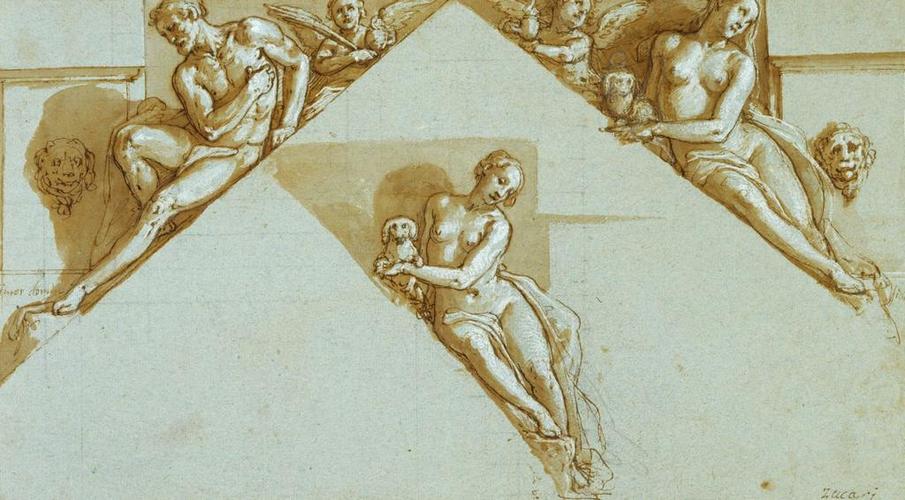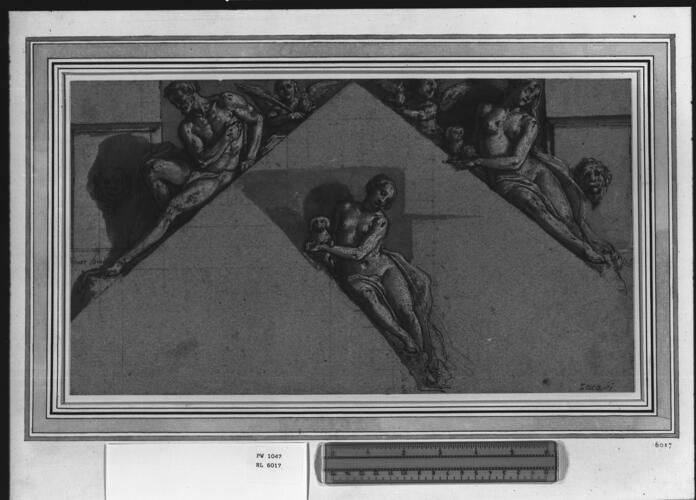Allegorical Figures c.1580
Pen and ink with wash and white heightening over black chalk, on blue paper, partly squared in black chalk | 22.2 x 40.0 cm (sheet of paper) | RCIN 906017

Federico Zuccaro (c. 1542-1609)
Allegorical Figures c.1580

Federico Zuccaro (c. 1542-1609)
Allegorical Figures c.1580

Federico Zuccaro (c. 1542-1609)
Allegorical Figures c.1580

Federico Zuccaro (c. 1542-1609)
Allegorical Figures c.1580




-
A drawing showing allegorical figures identified by the artist as 'Timor Domini' (left) and 'Fides' (right), designed to fill the angles of an arch; the figure of Fides with a spaniel is repeated in the centre of the sheet. These studies are for the decoration of the Cappella Paolina, Vatican. Federico Zuccaro followed his older brother Taddeo to Rome in the mid-1550s, and his long and productive career took him all over Italy and to the Netherlands, Spain and England. This is a study for a pair of allegorical figures in the vault of the Pauline Chapel in the Vatican. They are identified by the artist in his annotations Timor domini (‘Fear of the Lord’) to the left and fide (‘Faith’) to the right. This drawing is a study for a pair of allegorical figures painted by Federico Zuccaro in the vault of the Cappella Paolina in the Vatican designed by Antonio da Sangallo the Younger in 1537. The chapel is best known for the frescoes of the Conversion of St Paul and the Crucifixion of St Peter painted by Michelangelo in 1542-50, but most of the decoration was completed several decades later, during the papacy of Gregory XIII. Between 1573 and 1575 Lorenzo Sabatini painted three further wall frescoes in a Michelangelesque style, and after Sabatini’s death in 1577, Federico Zuccaro and his assistants added (in 1580-81 and 1583-5) a further wall fresco and decorated the vault with a stucco framework and frescoes of scenes from the lives of St Peter and St Paul. Above each of four triangular scenes in the vault is a pair of figures; the two here are found above Paul and Silas imprisoned at Philippi. In the drawing the bearded man is flanked by a winged angel carrying a palm of martyrdom and a chalice with the Host; the woman holds a lapdog and is accompanied by a putto bearing a flaming urn. The identity of these figures was given by the artist in the annotations timor domini (‘Fear of the Lord’) to the left and fide (‘Faith’) to the right. In the painting the figures are posed essentially as in the drawing, but the dog has disappeared (as have the lions’ masks on the architecture behind) and the other attributes are swapped over; it would seem that they are both intended simply to represent Faith. The figures are variants on the Adam and Eve in the spandrels of Cornelis Cort’s engraving of 1571 after Federico’s altarpiece of the Annunciation with the Mass. Those figures are not a feature of the arched altarpiece and were presumably devised by Zuccaro to ‘square up’ the composition for Cort. Nonetheless, it is clear from the attributes and inscriptions that this drawing was a study expressly for the Paolina project, and that Federico here adapted the figures that he had provided for Cort a few years earlier. Inscribed by the artist, centre left: [T]imor domini, and centre right: fide, and by a later hand, lower right: zucari Catalogue entry adapted from The Art of Italy in the Royal Collection: Renaissance and Baroque, London, 2007
Provenance
Royal Collection by c.1810 (Inventory A, p. 55, Zucharo Passarotti e Altri Maestri, among '21 to 45. Of Taddeo and Frederico Zucharo, their School, and other Masters in their Stile').
-
Creator(s)
-
Medium and techniques
Pen and ink with wash and white heightening over black chalk, on blue paper, partly squared in black chalk
Measurements
22.2 x 40.0 cm (sheet of paper)








